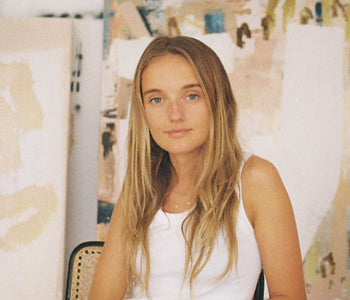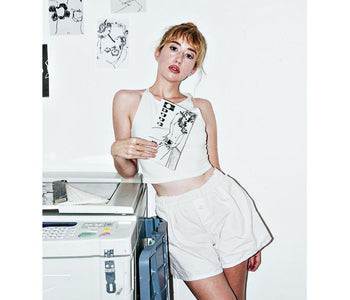In conversation
with
Donatien Grau

Photographed by Paolo Reversi
DONATIEN GRAU is a critic, scholar, and museum executive. He was selected by Apollo Magazine as one of the “Forty under Forty Europe” in 2014 and currently serve as the musée d’Orsay’s head of contemporary programs and as Chair of the Association Pierre Guyotat.
The Curators: With The Curators journal, we wish to pay tribute to the preparatory notebooks of the artists, with their references from all parts and all times (pictorial mnemosyne, literary quotes, contemporary work). The first notebook will have for theme: Eros.
What would be, instinctively, the artistic references that you would think of?
Donatien Grau: pascALEjandro, the spiritual, creative child of Pascale Montandon-Jodorowsky and Alejandro Jodorowsky ; Glenn Ligon’s word paintings, in which there is so much intensity through the material of each fragment of letter; Cecilia Granara, a young painter whose work is so imbued with eros.

pascAlejandro, Nous Deux, 2009

Cecilia Granara, I don’t know how to tell you but, 2018

Glenn Ligon. Take It or Leave It: Institution, Image, Ideology, 2017
Each of those bodies of work – and there could be many more – is a manifestation of union of things, beings, entities, in front of the disassembling of the world.


Eros playing flute, Athenian red-figure lekythos C5th B.C. Museum of Fine Arts Boston
Let’s return to the beginning : Hesiod. Eros is the opposite to Eris: the force of union as opposed to the force of disunion. Eros isn’t just about carnal desire between humans, it is the force of creative organization in the world.

Phanes, Modena Galleria Estense, C2nd B.C
The C. : Would you like to tell us a bit about your activities and your outlook? Because you seem, in everything you do, to be inhabited by a force, a sort of eros ?
Donatien Grau : That’s a difficult question. Let’s say that I’m privileged to have the energy to try to belong in the world – eros – and not seek disunion – eris. Whatever I do is related to a form of embrace of what can be done, and how something can be formulated in a way that would be absolutely right for itself, and the better version of itself.

Francesco Vezzoli, “Le gant d’amour (After de Chirico and Jean Genet)” (2010)
The C. : What would be your ideal representation of Eros?
Donatien Grau : As a Guyotat scholar, I am often told that Pierre’s work was erotic. And I entirely disagree. It seems to me that eros is more a question, a force, than it is a definition. Therefore, tackling eros does not mean being erotic. So, to answer your question, I have no idea about an inherently “erotic” work. However, I don’t know any significant work of art that does not confront eros.




